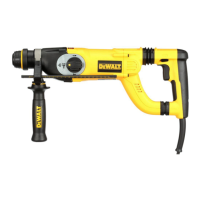ENGLISH
9
When using a cable reel, always unwind the cable
completely.
ASSEMBLY AND ADJUSTMENTS
WARNING: To reduce the risk of
injury, turn unit off and disconnect
machine from power source before
installing and removing accessories,
before adjusting or changing set-ups
or when making repairs. Be sure the
trigger switch is in the OFF position. An
accidental start-up can cause injury.
Selecting the Operating Mode
(fig. 2)
D25313, D25323, D25324
The tool can be used in the following operating
modes:
Rotary drilling: for screwdriving and for
drilling into steel, wood and plastics.
Hammerdrilling: for concrete and masonry
drilling operations.
Hammering only: for light chipping,
chiselling and demolition applications. In
this mode the tool can also be used as a
lever to free a jammed drill bit.
Bit rotation: non-working position used
only to rotate a flat chisel into the desired
position.
D25223
The tool can be used in the following operating
modes:
Rotary drilling: for screwdriving and for
drilling into steel, wood and plastics.
Hammerdrilling: for concrete and masonry
drilling operations.
Bit rotation: non-working position used
only to rotate a flat chisel into the desired
position.
Hammering only: for light chipping,
chiselling and demolition applications. In
this mode the tool can also be used as a
lever to free a jammed drill bit.
1. To select the operating mode, press the safety
lock (e) and rotate the mode selector switch
(d) until it points to the symbol of the required
mode.
2. Release the safety lock and check that the
mode selector switch is locked in place.
WARNING: Do not select the operating
mode when the tool is running.
Indexing the Chisel Position (fi g. 2)
The chisel can be indexed and locked into 51/52
different positions.
1. Rotate the mode selector switch (d) until it
points to the bit rotation symbol.
2. Rotate the chisel in the desired position.
3. Set the mode selector switch (d) to the
hammering only position.
4. Twist the chisel until it locks in position.
Inserting and Removing SDS Plus
®
Accessories (fig. 3)
This tool uses SDS Plus
®
accessories (refer to
the inset in figure 3 for a cross-section of an SDS
Plus
®
bit shank). We recommend using professional
accessories only.
1. Clean and grease the bit shank.
2. Insert the bit shank into the tool holder/locking
sleeve (f).
3. Push the bit down and turn it slightly until it fits
into the slots.
4. Pull on the bit to check if it is properly locked.
The hammering function requires the bit to be
able to move axially several centimetres when
locked in the tool holder.
5. To remove a bit, pull back the tool holder/
locking sleeve (f) and pull out the bit.
WARNING: Always wear gloves when
you change accessories. The exposed
metal parts on the tool and accessory
may become extremly hot during
operation.
Fitting the Side Handle (fig. 4)
The side handle (i) can be fitted to suit both RH- and
LH-users.
WARNING: Do not use the tool without
the side handle properly assembled.
1. Loosen the side handle.
2. For RH-users: slide the side handle clamp
over the collar behind the tool holder, handle at
the left.
For LH-users: slide the side handle clamp over
the collar behind the tool holder, handle at the
right.

